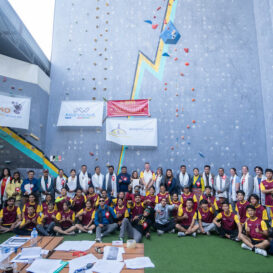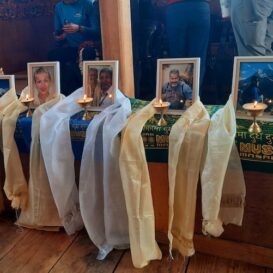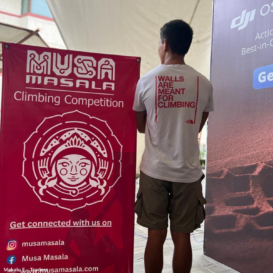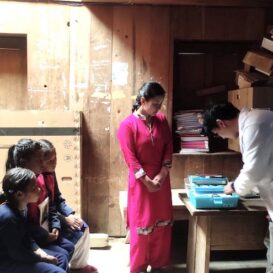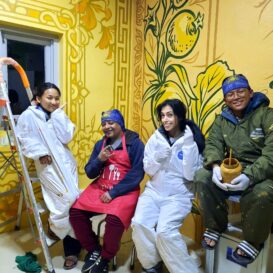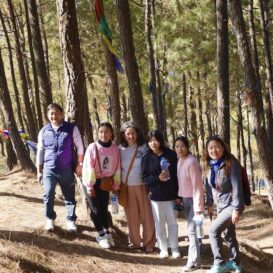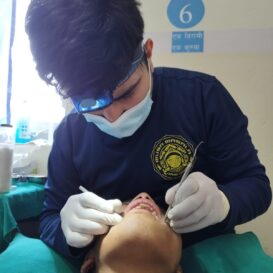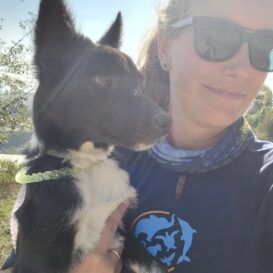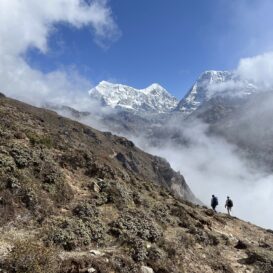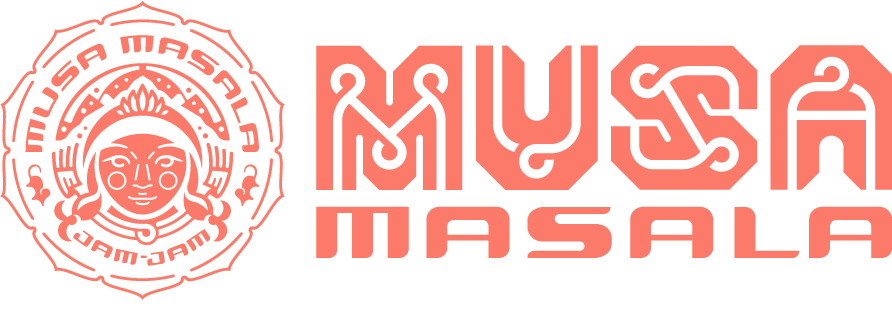I have to say this is one of my favorite posts ever. It covers so much of what Musa Masala has been working towards and cares about – a complete and open hospital to provide care in an area where people had few options available, and the people who do it. The ones providing the care and who really make the hospital happen.
How did this magical post come about, you may ask? Well, through the awesome efforts of Dr. Eric Johnson and the hard work of the Himalayan Yokpu Foundation. Dr. Marlena Strandir and her husband, Jason, visited the Wongchhu Sherpa Memorial Hospital Tapting this past October. They arrived for the opening ceremonies of the hospital with the team from the Wilderness Medical Society. They stayed on for two weeks to work with Dr. Gurung and the staff. You could not find two better people to fit right into the pace of the hospital.
My great sadness is that I (Mike Ji) did not get to meet them. I had to head back to Kathmandu to prepare for the Musa Masala Beginners’ Wall Climbing Competition. That involved a 12-hour Jeep ride, complete with floods, mud, flat tires, and the dreaded, heart-stopping Mirrors of Death survival challenge. (A story for another time…maybe?)
Here is the interview I did with Marlena after she returned. We all at Musa Masala are so thankful to them, and the hospital staff, for all the difficult work, the spirit that they bring to the hospital, and the forward thinking of all involved. Jam Jam!!
Musa: Can you tell us a bit about you and what you do in the regular world?( If there is such a thing…)
Dr. Strandir: I am a Family Medicine physician in Dillingham, Alaska. I get to do great medicine because there are no specialists in our region. The nearest tertiary care facility is 350 miles away by plane, which actually made the transition to a rural hospital in Nepal feel very natural. Dillingham was my first job out of residency and I just began my seventh year of practice here. I love my job.
I’m grateful that my husband, who had spent many years in the Arctic in a small roadside camp, was up for the challenges that come with living off the road system. Since we’ve been here we’ve welcomed two sons, now 4 and 2 years old. Jason is a stay-at-home papa, but he wears so many hats. Depending on the day, he’s a construction worker, electrician, tile man, chef, and commercial fisherman, but his true passion is rock climbing. He and a friend built a 13 foot wall in our garage and he spends as much time as he can out there training for big trips to the lower 48 and Mexico that keep him going.

Musa: Have you taken any of the CE experience trips with the WMS before?
Dr. Strandir: Nope.
Musa: Have you been to Nepal before?
Dr. Strandir: No. I’d been to Tibet and I think I expected a similar experience because of the shared border and some shared religion. It didn’t take long in Nepal to realize how detrimental China’s presence has been for the people, culture, and land of Tibet…or to realize what a dream Nepal is.
Musa: Tell us a bit about your trek before you got to the hospital.
Dr. Strandir: We ended up in the trekking group sort of accidentally. We had been in touch with Lakpa about our desire to volunteer at the hospital, and the only time we could go was in October. When she learned that, she let us know that we had good timing because that was when the hospital was going to be inaugurated and that there was even going to be an inaugural trek. She sort of threw us on it. We weren’t even WMS members so we didn’t know it was being led by the WMS, but we were up for it. It is hard to put into words how wonderful our group was.
The trek was led by two very strong and dynamic female physicians, Drs. Linda Keyes and Jennifer Dow (one former and one future president of the WMS). Our guides were so fun and confident, and our fellow trekkers were just impeccable. We had the good fortune of welcoming Dr. Luanne Freer to the end of our trek as well, which was such a treat for everyone. Each person added something to the group dynamic – it was just so special.
Despite the physical demand and intermittent illnesses, the monsoon rains, the poop soup that was the trail, and Everest’s constant cloud cover that kept us from viewing it until we got to Tapting, no one complained. I was so impressed. We can’t say enough about everyone – in only a week and a half we felt like a little family. We’re still in contact with everyone.

Musa: How did you come to be the first physician from the U.S. to consult at the hospital?
Dr. Strandir: Serendipity, I think. Eric Johnson (another past president of the WMS and integral member of the WSMH founding family) had been hired as a consultant at my hospital in Dillingham. He made frequent trips up for about a year and a half and we had him over for dinner often both because he’s very dynamic and fun to have around and to save him from the inevitable boredom that grips most visitors to Dilly in the winter.
Our dinner conversation would inevitably turn to Nepal every time he came over. He shared stories and photos and even Ang Rita’s laugh, which I have saved as a voice note on my phone. I was starting to get a bit burned out on the American healthcare system, and Eric recommended a simple fix: Go to Nepal. Eric was a big part of the WSMH’s formation, so we knew quite a bit about it and thought that’s where we’d like to start. We told Eric we’d like to go, he sent off an email to Lakpa, and in less than a week I heard back from her and her team and the ball rolled from there.
Musa: How did you feel when you first flew into the hospital?
Dr. Strandir: I think we were both pretty overcome…coming in by helicopter allowed us to appreciate everything about the hospital – it’s perfect perch on the hill, the bustling rural villages it serves, the beauty of the surrounding mountains. And having recently been on the trail to Everest Base Camp, we had seen what it takes to build anything in those mountains. I was so proud of Lakpa and her team, Eric, Lulu, Paul, and everyone else who made Wongchhu’s dream of that hospital a reality. What a feat. It is perfect.

Musa: Where did you guys stay, on the hospital grounds?
Yes. There are four dorm rooms, each with an attached bathroom, that make up one of the current 3 buildings on the hospital compound. Kuma Sister, one of the hospital staff, was kind enough to give up her quarters for the time that Jason and I were there. We’re so grateful to her.
Musa: You guys got to meet the great Rudra Rai, who was painting the roof and the birthing center. What did you think of Rudra? He is my favorite, so talented and SO eccentric!
Dr. Strandir: Jason spent much more time with him than I did, as Jason helped him finish up the roof of the hospital. I’ll turn it over to Jason for this question:
Jason: As the non-medical member of the team, I was concerned that I wouldn’t be of much use volunteering at a hospital, and was eager to find ways to be useful. Most of the work I have done over the past 6 years has been with my hands, and when I saw Rudra painting giant block letters up on the roof I thought ” I could do that.” He was more than happy to take me on as his apprentice and we hit the ground (or roof I suppose) running. I ended up spending almost the entire day up on that roof with him and was pleasantly surprised at how easy and comfortable conversation was with him. We talked about everything from work and family to politics and motorbikes, and all while he meticulously counted ribs on the corrugated metal roof to make sure the layout of the letters fit perfectly across the roof. It was a pleasure and an honor to work with such an interesting and talented person.
Musa: Can you tell us a bit about the staff at the hospital?
Dr. Strandir: Oh man…what an incredible group of people. I get a bit teary-eyed just thinking about them. They are a small group, but they are mighty. Everyone works so hard and they have such a perfect group dynamic. Each person knows their role and does it perfectly. I often felt like I was in the way, but was still happy to be a part of the hive.
Dr. Gurung and I are still in touch and we talk about cases probably once a week. I hope I never lose touch with him. He is one of the most interesting people I have ever met, and I think he is going to do great things.
Ashal is in charge and you can tell he has so much pride in his job and the hospital. He was always willing to learn and striving to make the hospital better.
Dhan Bahadur is Dr. Gurung’s Health Assistant. He has an incredible work ethic and plays a mean drum solo around a campfire – we miss those.
The nurses, Sashi Magar and Yang Di Sherpa are so calm and capable. I loved working with them. I felt especially connected to Sashi despite our language barrier as she lived next door and was always up for hanging out after hours.
Chhemi Sherpa and Mina Tamang are the quiet but fiercely talented leaders of the Maternity Ward and Family Planning Dept. I’ve delivered more babies than I can count and I still felt better knowing they were around.
Damu(sp?) Sherpa and Babita are the two ladies who take care of cleaning and cooking at the hospital. What wonderful women. They were constantly working and always had a smile to share. And Babita’s little daughter Junita, who I consider the mascot of WSMH, is the spunkiest little peanut I’ve ever met. She’s so sassy and she has Dr. Gurung wrapped around her little finger. 🙂
Kuma Rai is the lab tech – she’s outstanding in her position and the person who was generous enough to lend us her living quarters. The hospital is so lucky to have her on staff.
Amur is the ambulance driver. He and his wife welcomed their first baby last month. His family lives nearby and I got to meet them – they were unbelievably generous. And Amur…I saw him drive that box truck of an ambulance over ruts that were half as deep as I am tall on the side of a cliff and he didn’t flinch. He also doesn’t blink when you ask him to drive ten hours to Kathmandu to transport a patient (think Grand Theft Auto on winding mountain roads where the road narrows to one lane on the curves). He’s another invaluable cog in the well-oiled machine that is WSMH.
And then there is Sudip, the x-ray tech, posted there by the government for 8 months despite the fact that the x-ray machine had not arrived yet (it has since arrived). Despite being a bit displaced by this bureaucratic hiccup, he was always around to lend a helping hand. I’m pretty sure he knows every single person in the twelve closest villages and there’s never a dull moment with him. He certainly made sure Jason was always having a good time.

Musa: Was it easy to communicate with everyone?
Dr. Strandir: I want to confess that Jason and I boarded our flight to Kathmandu having learned zero Nepali. The Nepali that we did learn is mostly food-related, so I was hopeless as a physician. The Good Doctor Gurung (that is what I call him – it just fits) speaks 5 languages and thankfully, one of them is English. We saw patient’s together and he was a great translator. If he saw patients without me, he would often consult with me and we could put our heads together to determine the best treatment plan. It was really fun. Most of the rest of the staff speak at least a few words of English, so we would just speak to them like they were fluent and they humored us.
Out in the community, many people speak some level of English. We ended up speaking with parents and grandparents through the children, most of whom are learning English in school. One of our favorite things about rural Nepal is that even if you only know one word of Nepali – “Namaste”, it unleashes a smile and an echoed Namaste from anyone you greet with it. And oftentimes that smile and greeting opens a door, pours endless cups of tea, and leads to hours of animated, partially understood conversation. We also communicated through food and through dance. We just did our best to respect the culture that was being shared and assimilate when we were invited to do so, which was often.
Musa: Tell us about what you did and saw at the hospital for the two weeks.
In the beginning, I was seeing a lot of patients with the Good Doctor. We hadn’t realized that nearly half of the month of October is considered a government holiday, so for much of our later time in Tapting, the hospital clinic was closed except for emergencies.
Luckily, the hospital had a government inspection just before the big break for Tihar, and we had a good idea of what the hospital needed to improve before the next government inspection. One of those things was the organization of the Pharmacy. That was a two day adventure. Once that was done, we took on the Store Room with Dr. Gurung. It was satisfying work, as we felt like we were contributing to the future success of the hospital.
Musa: Did you guys take some side trips around Khamding and see some other sights?
Dr. Strandir: We went up to the Jhapre Monastery often and we got to do a sunrise hike up Pikey Peak with a small group from Tapting. That was too cool – watching the sun rise over the Himalayas and watching the light hit each peak, one by one…magic.
Musa: So give us an overview of your impression of the trip. Would you like to go back?
Dr. Strandir: We can’t wait! We brought home so many little pieces of Nepal to keep it fresh in our minds. Our home reminds us of Nepal every day…there’s a prayer wheel next to our front door and a painting of a yak by Rinchhen Norbu Sherpa that we bought in Namche in our dining room.
Our most treasured item that we brought back is a beautiful brass ceremonial water pitcher that was gifted to us by the staff of WSMH. We’re planning to take our sons next time. Our 4 year old has started eating hot sauce at dinner and the first time we tried to caution him against it he said, “I’m training for Nepal.” We’re excited to get back to Tapting and the staff and families who welcomed us. Our only regret is that we will miss those who have moved on, which we assume will happen since several of them are on government posts.
Learn more about the Himalayan Yokpu Foundation here.






